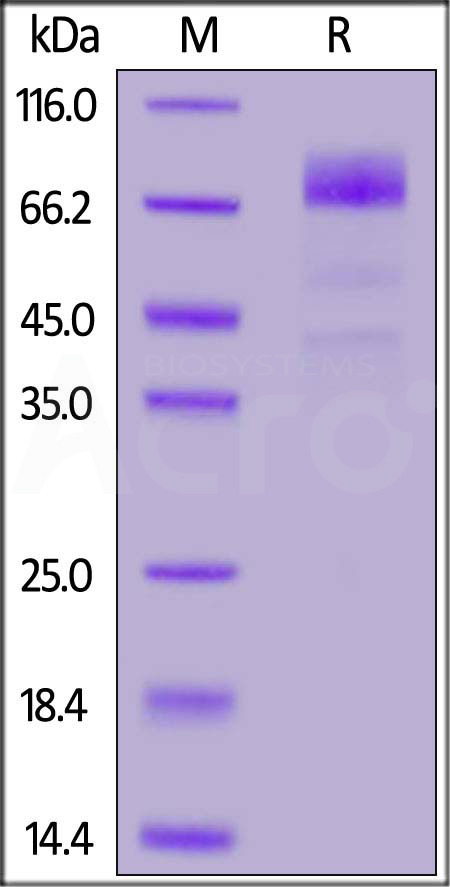分子别名(Synonym)
CD36,SCARB3,BDPLT10,CHDS7,FAT,GP3B,GP4,GPIV,PASIV,Platelet Glycoprotein 4,glycoprotein IV,gpIV,glycoprotein IIIb,gpIIIb
表达区间及表达系统(Source)
Biotinylated Human CD36, His,Avitag (CD6-H82E9) is expressed from human 293 cells (HEK293). It contains AA Gly 30 - Asn 439 (Accession # NP_001001547.1).
Predicted N-terminus: Gly 30
Request for sequence
蛋白结构(Molecular Characterization)

This protein carries a polyhistidine tag at the C-terminus, followed by an Avi tag (Avitag™).
The protein has a calculated MW of 50.2 kDa. The protein migrates as 66-90 kDa under reducing (R) condition (SDS-PAGE) due to glycosylation.
标记(Labeling)
Biotinylation of this product is performed using Avitag™ technology. Briefly, the single lysine residue in the Avitag is enzymatically labeled with biotin.
蛋白标记度(Protein Ratio)
Passed as determined by the HABA assay / binding ELISA.
内毒素(Endotoxin)
Less than 1.0 EU per μg by the LAL method.
纯度(Purity)
>90% as determined by SDS-PAGE.
制剂(Formulation)
Lyophilized from 0.22 μm filtered solution in PBS, pH7.4 with trehalose as protectant.
Contact us for customized product form or formulation.
重构方法(Reconstitution)
Please see Certificate of Analysis for specific instructions.
For best performance, we strongly recommend you to follow the reconstitution protocol provided in the CoA.
存储(Storage)
For long term storage, the product should be stored at lyophilized state at -20°C or lower.
Please avoid repeated freeze-thaw cycles.
This product is stable after storage at:
- -20°C to -70°C for 12 months in lyophilized state;
- -70°C for 3 months under sterile conditions after reconstitution.
电泳(SDS-PAGE)

Biotinylated Human CD36, His,Avitag on SDS-PAGE under reducing (R) condition. The gel was stained with Coomassie Blue. The purity of the protein is greater than 90%.
活性(Bioactivity)-ELISA

Immobilized Human R-Spondin 1, His Tag (Cat. No. RS1-H4221) at 5 μg/mL (100 μL/well) can bind Biotinylated Human CD36, His,Avitag (Cat. No. CD6-H82E9) with a linear range of 0.313-1.25 μg/mL (QC tested).
Protocol
背景(Background)
CD36 (Cluster of Differentiation 36) is also known as platelet membrane glycoprotein IV (GPIV), fatty acid translocase (FAT), thrombospondin receptor, collagen receptor, and scavenger receptor class B, member 3 (SRB3), is a member of the class B scavenger receptor family of cell surface proteins. The human CD36 gene encodes a single chain 472 amino acid residue protein containing both an N- and a C-terminal cytoplasmic tail and an extracellular loop.CD36 is found on platelets, erythrocytes, monocytes, differentiated adipocytes, mammary epithelial cells, spleen cells and some skin microdermal endothelial cells. CD36 is a multiligand pattern recognition receptor that interacts with a large number of structurally dissimilar ligands, including long chain fatty acid (LCFA), advanced glycation end products (AGE), thrombospondin-1, oxidized low-density lipoproteins (oxLDLs), high density lipoprotein (HDL), phosphatidylserine, apoptotic cells, beta-amyloid fibrils (fAβ), collagens I and IV, and Plasmodium falciparum infected erythrocytes. CD36 is required for the anti-angiogenic effects of thrombospondin1 In the corneal neovascularization assay. On binding a ligand the protein and ligand are internalized. This internalization is independent of macropinocytosis and occurs by an actin dependent mechanism requiring the activation Src-family kinases, JNK and Rho-family GTPases. CD36 ligands have also been shown to promote sterile inflammation through assembly of a Toll-like receptor 4 and 6 heterodimer.























































 膜杰作
膜杰作 Star Staining
Star Staining











